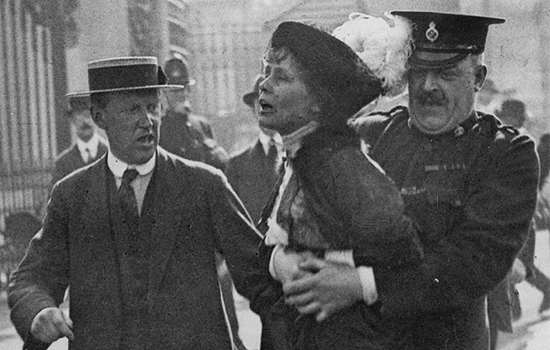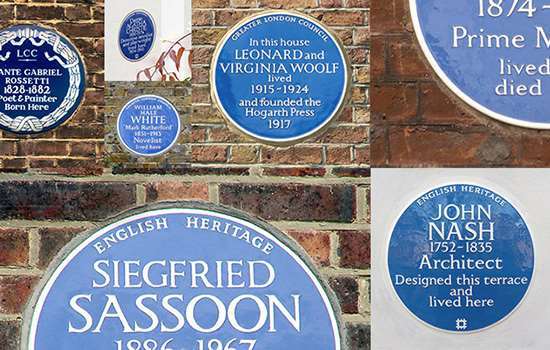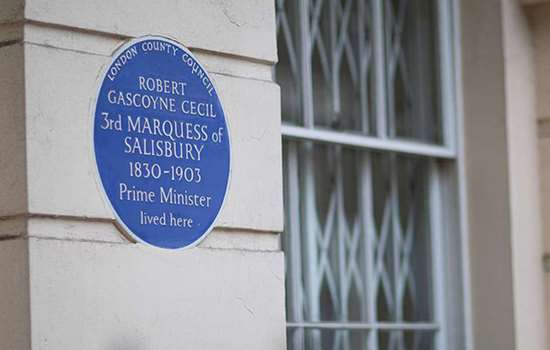CLARKSON, Willy (1861–1934)
Plaque erected in 1966 by London County Council at 41-43 Wardour Street, Soho, London, W1D 6PY, City of Westminster
All images © English Heritage
Profession
Theatrical Wigmaker
Category
Applied Arts, Commerce and Business, Theatre and Film
Inscription
WILLY CLARKSON 1861-1934 THEATRICAL WIGMAKER lived and died here
Material
Ceramic
Notes
The LCC plaque was erected under the aegis of the GLC.
William Berry, or ‘Willy’, Clarkson was a theatrical wigmaker and costume designer. A blue plaque at 41–43 Wardour Street, Soho, marks the building where he lived and ran his business, from 1905 until his death.
Costumier and Wigmaker
Willy Clarkson was born in London into a Jewish family, and was the son of a wigmaker – inheriting his father’s business at the age of 12. When he first took over, the business was based at Wellington Street, near The Strand, but it would later move to 41–43 Wardour Street. Clarkson recalled that he ‘never ’ad any toys like an ordinary kid. Father used to give me a wig to play with.’
The business flourished and at the height of his success, Clarkson was hiring out 10,000 wigs each Christmas. For over 50 years the announcement ‘Wigs by Clarkson’ appeared on theatre programmes everywhere. In 1888, the business was granted a royal warrant by Queen Victoria, for whom Clarkson supplied wigs and costumes for performances at Osborne and Blamoral.
Clarkson forged further success as a designer and maker of theatre costumes. The most famous actors of the day came to him for their costumes, while others hired clothes for military tournaments and fancy-dress balls, which were popular at the time.
In 1898, before his move to Wardour Street, Clarkson was taken to court for illegally employing women to work on a Sunday. He was ordered to pay court costs of £3 9s 6d.
Master of Disguise and fraud?
One of Clarkson’s specialities was the provision of disguises. In 1936, Adrian Stephen recalled that Clarkson created the costumes for the members of the infamous ‘Dreadnought hoax’ – a prank pulled by Horace de Vere Cole in 1910 that tricked the Royal Navy into showing their flagship, HMS Dreadnought, to a fake delegation of Abyssinian royals. Among the hoaxers disguised as one of the Abyssinian delegation was Adrian’s sister, Virginia Woolf.
Less reliably, it has been claimed that Clarkson may have – albeit inadvertently – ‘disguised Jack the Ripper himself, besides the detectives and medical students who went to search for him’, and Dr Crippen, another infamous murderer, was also claimed to be one of Clarkson’s clients.
Clarkson’s own death, in October 1934, was apparently considered sufficiently suspicious for an autopsy to be ordered, though no clear evidence of foul play was found. A wound to his head was caused, said an obituary, by him having collapsed and hit his head.
Recent histories have suggested that Clarkson, who was likely to have been homosexual, could have been a victim of blackmail, as well as possibly a perpetrator of it too. He has also been accused of fraud over fire insurance: two companies successfully sued his estate for the return of money paid out for claims.
Wardour Street
The impressive building at 41–43 Wardour Street in Soho, to the south of the intersection with Shaftsbury Avenue, was Clarkson’s home and workplace from 1905 until his death. The building was designed by HM Wakley for Clarkson’s expanding business and was built with red brick and green stone, featuring three levels of wide windows.
Bronze plaques were erected on either side of the entrance to record the laying of the foundation stone by French actress Sarah Bernhardt in 1904, and the coping stone by Victorian actor Sir Henry Irving in 1905. Doubt has been cast on whether Irving, who was in poor health by that time, actually laid the stone.
The top floor of the building contained a flat for Clarkson to live in. His living quarters were, by the time of his death, ‘crammed with the junk of a make believe life time’.
The blue plaque was installed in 1966, 32 years after Clarkson’s death, under the aegis of the GLC (Greater London Council). It is set up high, at the centre of the building’s facade and just below the clock which still advertises the premises of a ‘Costumier and Perruquier’ (wigmaker). The plaque was nominated by Clarkson’s god-daughter Mrs Diane Evans and the proposal was supported by many thespians who had known Clarkson, among them Sir Laurence Olivier and Dame Sybil Thorndike.
Further Reading
Obituary in The Times, 15 October 1934
‘Clarkson’s Wigs, Wardour Street, London’, The Music Hall and Theatre History Site (acccessed: 27 July 2021)
Nearby Blue Plaques
More About Blue Plaques



